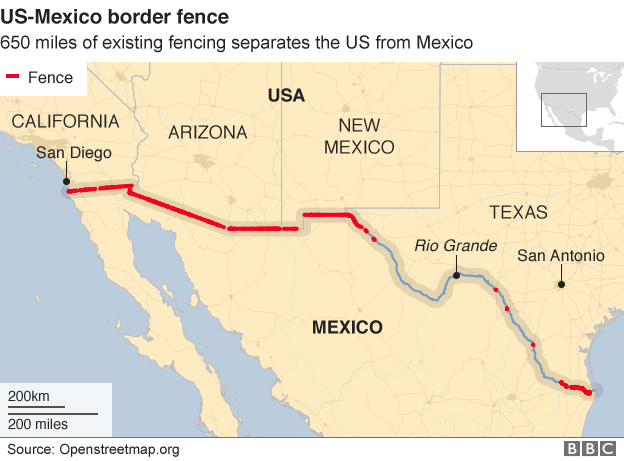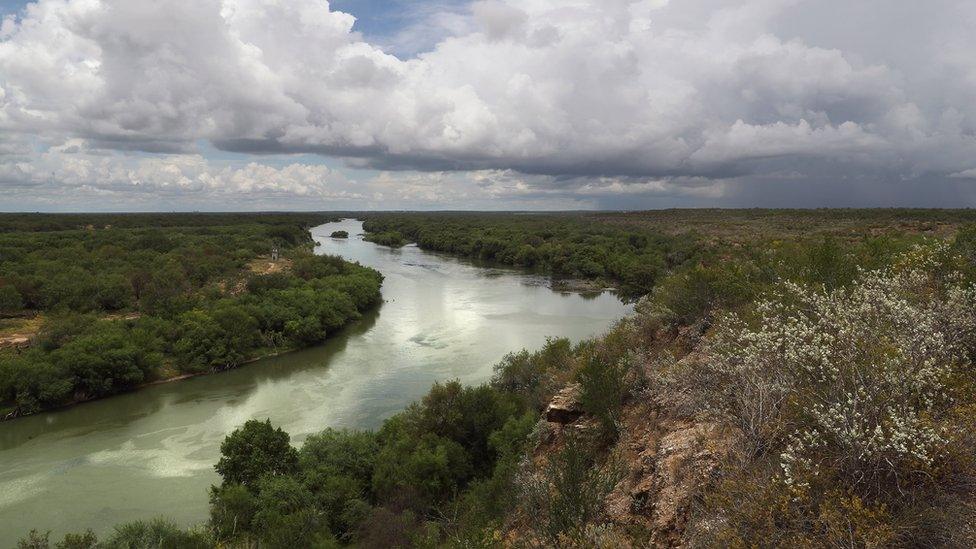Donald Trump's Mexico wall: Who is going to pay for it?
- Published
How will President Trump deliver on border wall promise?
President Donald Trump has set in motion his plan to build an "impenetrable, physical, tall, powerful, beautiful, southern border wall" between the US and Mexico.
The border is about 1,900 miles (3,100 km) long and traverses all sorts of terrain.
Mr Trump says his wall will cover 1,000 miles and natural obstacles will take care of the rest.
But how much will it cost and who is going to foot the bill?
What is the estimated budget?
"I would build a great wall, and nobody builds walls better than me, believe me, and I build them very inexpensively."
Mr Trump claims the total cost of the wall will be $10bn (£7.5bn) to $12bn. But estimates from fact checkers and engineers seem to be universally higher.
Senate Majority Leader Mitch McConnell estimated it will cost between $12-15bn, as he addressed reporters at a Republican conference in Philadelphia.
What Republican delegates said about Trump's wall before the election
The 650 miles of fencing already put up has cost the government more than $7bn, and none of it could be described, even charitably, as impenetrable, physical, tall, powerful or beautiful.
There are other reasons the costs would be likely to escalate beyond Mr Trump's price tag - his plans require extending the wall into increasingly remote and mountainous regions, raising the building costs substantially.

Adding even more to the expense, the new 1,000 miles would crisscross private land, which would have to be purchased, perhaps by legal force, or financial settlements made with owners.
A study by the Washington Post estimated the cost of the president's wall would be closer to $25bn.
The row over payment
President Trump has always insisted Mexico will pay. Mexican President Enrique Pena Nieto has been equally insistent he will not.
The US-Mexican family split by the border
Needing to fulfil his election pledge to start building on day one, Mr Trump has signed an executive order setting it in motion.
He has accepted that US taxpayers will have to cover the initial funding.
Congressional approval would be needed and Republicans have suggested a supplemental appropriations bill could be fleshed out over the next two months.
So, how would that money be recouped from Mexico?
There are a number of options, but nothing has been officially decided.
1. Raising tariffs on imports. Mr Trump's spokesman, Sean Spicer, said on 26 January that the president wanted a 20% tax on Mexican imports to pay for the wall, although he later added that it was one of several options still being considered. "By doing it that way we can do $10bn (£8bn) a year and easily pay for the wall, just through that mechanism alone," he told journalists. Forbes has argued that, external existing duties on Mexican goods would have to be quadrupled to pay for the whole of the wall, even if its cost were spread over 10 years. US companies would also almost certainly source products from elsewhere, reducing the revenue. The Mexican government could respond by removing tax benefits for US foreign investment. The investment totalled $101bn in 2013.
2. Remittances. Two possibilities here. President Trump could try to use laws aimed at preventing money-laundering to halt Mexicans working in the US from wiring money to families back home. The sector is huge - about $25bn a year. The hope is that the threat would cow Mexico into coughing up for the wall. The second option is to tax the remittances. Either a flat tax on all, or a far more punitive tax on those who cannot prove legal residence. But Mexicans affected by remittances might simply avoid using the wire companies and find undocumented third parties to transfer the cash.
3. Levying a "border adjustment" tax. House Republicans propose lowering corporation tax from 35% to 20% but base it on the place of consumption, not production. Imports would be taxed but not exports. A 20% tax, given the $60bn trade deficit with Mexico, would raise $12bn a year. Mexico could do little, the Washington Post reports, external, because border adjustments would apply to all US trading partners and would not therefore be seen as a singling out Mexico.
4. Increasing travel visa and border crossing fees. Targeting countries that have a bad record on illegal immigration, including Mexico, for higher visa fees would be popular among many Republicans. Along with increasing the fees on cars and individual people crossing the border it would raise revenue, but would probably not be enough alone.
Asked whether any of his solutions were realistic, he told the Washington Post: "It's realistic if you know something about the art of negotiating. If you have a bunch of clowns negotiating, it's not realistic."
What type of wall will he build?
Throughout his presidential campaign, Mr Trump was adamant that he would fortify the southern border with a wall ("a wall is better than fencing and it's much more powerful").
Concrete is the obvious choice. Ali F Rhuzkan, a New York-based structural engineer, estimated in an article for National Memo, external that a 1,900-mile wall - seemingly Mr Trump's original plan - would require about 339 million cubic feet (12.5 million cubic yards) of concrete - three times more than the Hoover Dam.
Mr Rhuzkan's estimate was based on a wall that ran 5ft beneath the ground and 20ft above. Mr Trump's claims for the wall range between 30ft and, more recently, 55ft. Even at 1,000 miles - vast amounts of concrete would be required.
That concrete, Mr Rhuzkan wrote, would need to be manufactured in slabs nearby - likely in dedicated plants - and transported to building sites, with all the enormous production and staffing costs involved.
However, since assuming office, Mr Trump's secretary of Homeland Security has said that parts of the wall will be transparent.
"There will be the physical wall and then parts of the wall that you can actually see through because it will rely on sensors and other technology," Secretary John Kelly told Fox News.
What about the environment?
Free movement between the US and Mexico is not just a human issue. What would the construction of a wall mean for animals that live near the border?
The US-Mexico border region is a delicate ecosystem with regular animal and bird migrations moving between the north and south of the American continent.

The Rio Grande flows along sections of the US-Mexico border
A number of species need to cross the border to mate with their genetically different cousins, including the endangered North American jaguar and black bears, which would be threatened without being able to mate with Mexican bears.
The wall would also have to take into account natural flooding zones as well as large areas of sand, where the ground effectively moves.
Then there is the detrimental impact to the landscape of a massive construction project - digging, road building, and the appearance of a concrete wall up to 50 feet high, notwithstanding Mr Trump's pledge that it will be "very beautiful".